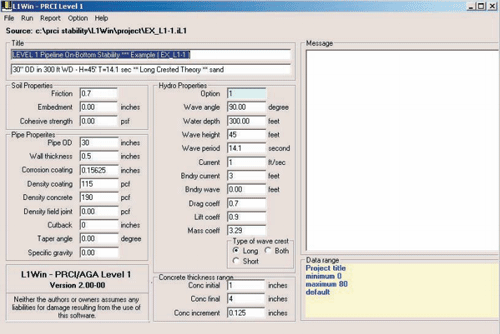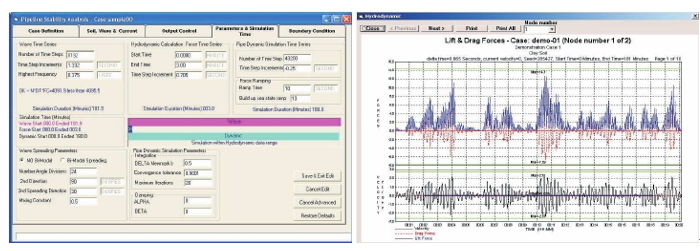AGA/PRCI SUBMARINE PIPELINE ON-BOTTOM STABILITY ANALYSIS SOFTWARE
& SUB-SEA PIPELINE DESIGN STANDARD VERSION 3.0
The AGA/PRCI
Submarine Pipeline On-Bottom Stability Analysis Software & Sub-Sea Pipeline
Design Standard (AGNPRCI OBS) was developed by Halliburton Kellogg Brown &
Root (KBR) under contract to the Pipeline Research Council International, Inc.
(PRCI). The AGA/PRCI OBS is considered the world standard for the design and
analysis of sub-sea pipelines.
AGA/PRCI OBS features
calculation of kinematics from 3-D irregular waves, several hydrodynamic force
models, models for partial burial, non-linear, time dependent interaction between
pipeline and soil (sand and clay) and non-linear pipeline material properties
(for boundary elements). This allows for detailed analysis of specific pipeline
sections subjected to specified environmental conditions. The new release
consists of three levels with:
1, Level 1 being used for quick simplified analysis
2, Level 2 for comprehensive detailed deign and modeling (most used)
3, Level 3 for advanced and very complex sub-sea pipeline design
modeling
Level 1:
Used for quick
and simplified analysis calculates the static stability of an un-trenched
pipeline against lateral and vertical displacement under wave and current loading.
Drag, lift, and inertial forces are considered along with the restraining
effect of either cohesive or non-cohesive soils. This restraining effect is
dependent upon the soil friction factor and pipe submerged weight for
non-cohesive soils, and on the cohesive shear strength and pipeline embedment
depth for cohesive soils.
Level 1 is quick
and easy to use with all inputs being controlled from a single window.

The AGA/PRCI OBS
Levels 1 and 2 calculates the stability safety factor for a specified range of concrete
thicknesses to permit an optimum thickness to be chosen .AGA/PRCI OBS also gives
load-effect prediction for a given specified submerged weight (or concrete
coating thickness), i.e. accumulation of displacements during a sea state with specified
probability of occurrence.
Level 2:
The AGA/PRCI OBS Level 2 is a design tool for on-bottom submarine pipelines, which calculate the submerged pipe weight to meet specified design criteria. The AGA/PRCI OBS computer program is based on the use of non-dimensional parameters, which allow scaling of the environmental load effects, the soil resistance and the pipeline response (lateral pipe displacement). The AGA/PRCI ass computer program was initially developed as a part of a comprehensive Research program, and has been further revised as a consequence of the development of new models for the hydrodynamic and soil-force description. The design philosophy allows for limited movements of the pipeline during extreme environmental conditions. The design process utilizing the program starts with a definition of a long-term wave environmental description. The long-term wave elevation data is transformed to water particle velocity data at a significant amplitudes and up-crossing periods of water velocity for the seabed. These data then form the basis for the description of the long term hydrodynamic loading process, and are used by the program for the pipeline stability design according to the specified design criteria. Two principally different design checks can be made for the stability control of the pipeline: as laid on-bottom section. The basis for the design process is in this case a generalized response database generated through series of pipeline response simulations with the computer program AGA/PRCI a s s Level 2. The ass level 2 design check makes an absolute static stability calculation of a pipeline on bottom sand or clay. This design check is based on a static equilibrium between the hydrodynamic design loads and the soil capacity.
Hydrodynamic forces are obtained from maximum conditions and soil resistance forces are based on updated models.
Level 2 is quick and easy to use with all inputs being controlled from a single window.

Level 3:
AGA/PRCI OBS Level 3 is a Finite Element Model (FEM) formulation, based on 2-D elements which solves, in the time domain, the equations of motion of the pipeline in the horizontal plane using small deflection theory, but accounting for bending deformation effects on axial forces. The program can simulate a design storm for up to 101 nodal points. The Level 3 program consists of top level, user interface for data input (see below), program control, viewing of output and plotting of results. The three (3) core program modules include: WINWAVE, the random Wave Generation module; WINFORCE, the Hydrodynamic Force module; and WINDYN, the dynamic simulation module.
The Random Wave Generation module WINWAVE simulates water particle velocity time series that result from wave motion at the sea surface, The time series are simulated at grid points on the sea floor that correspond to the pipeline route, The velocity time series simulated at each pipe node is passed to the hydrodynamic force module, Plot output of the velocities is available and can be referenced to check the simulation output shown above.
Based on user input of coated pipe diameter, pipe roughness, current velocity, etc., and the output velocity time series, the WINFORCE program module produces a time series of hydrodynamic drag and lift force at each pipe node. The main assumption behind the program is that the Fourier expansion of the measured drag and lift forces in regular waves, as determined during the PRCI model tests (PRCI Project PR-170-185), can be used to calculate the forces associated with the individual waves in irregular waves when taking into account the effect of the flow history, the so called "wake effect'. The forces are computed for the stationary pipe, which is fully exposed (no partial burial). The force time series are passed to the dynamic simulation module.

The attributes of AGA/PRCI OBS Level 3 are summarized below:
Pipe Structure
1, Straight pipeline on horizontal sea-bottom (nofree spans)
2, Two degrees of freedom (lateral deflection and rotation about global vertical axis) at each nodal point
3, Variable pipe mechanical and geometric properties along the pipe
4, Variable end conditions (free, fixed or spring)
5, Tension effects: optional (the pipe may have an initial axial force that may increase due to lateral deflection)
6, Pressure effects (the pressure will contribute to the effective axial force and internal pressure may give tensile stress along the pipe axis)
Soil Force
1, Elasto-plastic model with possible hardening and softening effects for clay and coarse sand(transverse to pipeline)
2, Transverse soil properties may vary along the pipe
3, Axial soil force along the pipe is not considered
Hydrodynamic Force (lift force included)
1, Regular and irregular waves with user-defined direction relative to the pipe
2, Constant current in time
Numerical Method
1, Finite element formulation with straight beam elements with two degrees of freedom at each node (rotation and transverse displacement)
2, Small deflection theory (small rotations) for the beam elements with linear material behavior (no updating of nodal coordinates)
3, Geometric stiffness is included
4, Concentrated mass formulation
5, Constant time step (user specified)
6, Simple trapezoidal integration for the distributed loading along the beam elements (nodal forces only, no moments)


